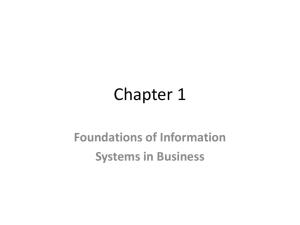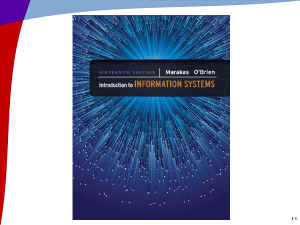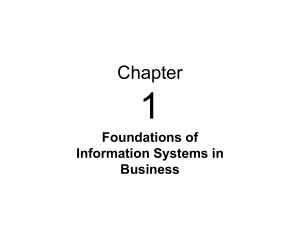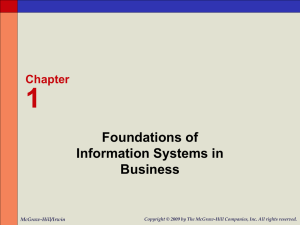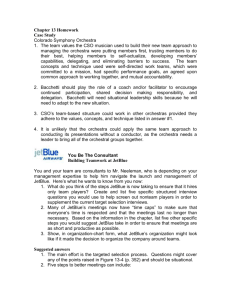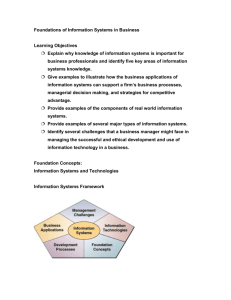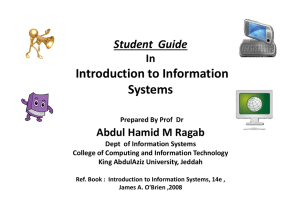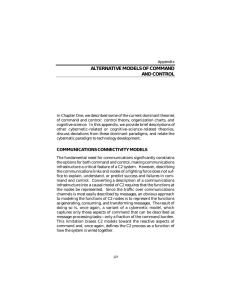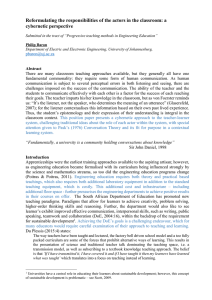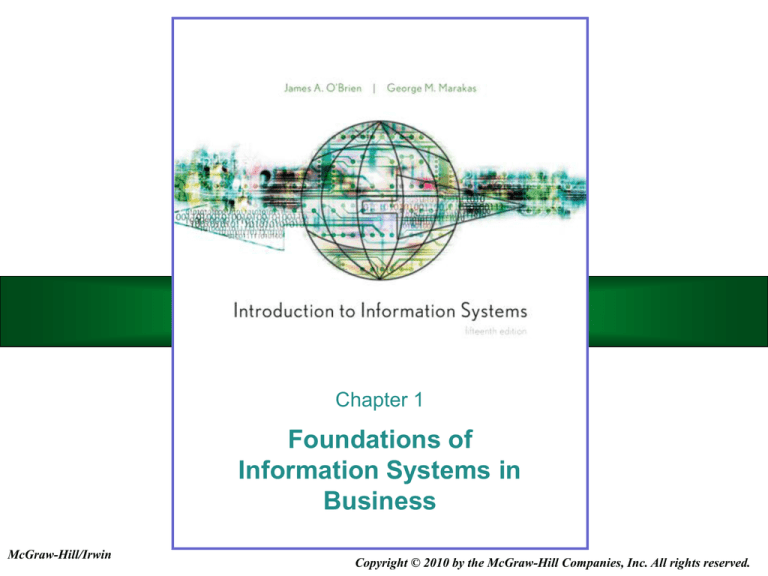
Chapter 1
Foundations of
Information Systems in
Business
McGraw-Hill/Irwin
Copyright © 2010 by the McGraw-Hill Companies, Inc. All rights reserved.
Learning Objectives
Understand the concept of a system and
how it relates to information systems
Explain why knowledge of information
systems is important for business
professionals
– Identify five areas of information systems
knowledge they need
1-2
Learning Objectives
Give examples to illustrate how information
systems can support a firm’s
– Business processes
– Managerial decision making
– Strategies for competitive advantage
Provide examples of information systems from
your experiences with business organizations
in the real world
1-3
Learning Objectives
Identify challenges that managers might face
in managing successful, ethical development
and use of information technology
Provide examples of the components of real
world information systems
Become familiar with the myriad of career
opportunities in information systems
1-4
Foundation Concepts
Vital component of
successful businesses
Improves efficiency and
effectiveness of
business processes
Why study
information systems and
information technology?
Strengthens
competitive position in
rapidly changing
marketplaces
Facilitates managerial
decision making
& workgroup
collaboration
1-5
Case 1: Value Through Business Intelligence
eCourier
– Tracks customer
satisfaction in real time
– Immediate attention to
complaints, problems
– Allows GPS tracking of
couriers and orders
– Books 95% of deliveries
online
– Uses SeeWhy software
to spot trends and anomalies
– Optimizes system on an ongoing basis
1-6
Case 1: Value Through Business Intelligence
Cablecom
– Uses online surveys to retain customers
– Responds to complaints and problems within
24 hours
Bryan Cave
– Optimizes resources while delivering highest
customer value
– Allows lawyers to track budgets in real time
– Provides diversity dashboard
– Enables firm to monitor client needs
– Allows quick response to demands
1-7
Case Study Questions
How do information technologies contribute to
the business success of the companies
depicted in the case?
– Provide an example from each company,
explaining how the technology implemented
led to improved performance
1-8
Case Study Questions
The Bryan Cave law firm used BI technology
to improve the availability, access, and
presentation of existing information; this
allowed them to provide tailored, innovative
services to customers
– What other professions could benefit from a
similar use of these technologies, and how?
1-9
Case Study Questions
Cablecom developed a prediction model to
better identify customers at risk of switching
to another company
– In addition to those noted in the case, what
other actions could be taken if that information
were available?
– Would you consider letting some customers
leave anyway?
1-10
What is an Information System?
Communication
networks
Policies and
procedures
People
Any organized
combination of…
Data resources
Hardware and
software
Stores, retrieves, transforms,
and disseminates information
in an organization
1-11
Early Information Systems
They weren’t computerized
– Smoke signals
– Library card catalogs
– Book bag, day planner, and notebooks
– Cash registers
– Accounting ledger
1-12
What Should Business Professionals Know?
1-13
Fundamental Roles of IS in Business
1-14
Trends in Information Systems
1-15
What is E-Business?
Using Internet technologies to empower…
Business processes
Electronic commerce
Collaboration within a company
Collaboration with customers, suppliers,
other business stakeholders
In essence, an online exchange of value
1-16
How E-Business is Being Used
1-17
E-Business Use
Reengineering
Internal
business
processes
Enterprise
collaboration
Electronic
commerce
Support
communication,
coordination,
coordination
among teams
and work
groups
Buying,
selling,
marketing,
and servicing
of products
and services
over networks
1-18
Types of Information Systems
Transaction processing
Operations
Process control
Enterprise collaboration
Updating of corporate databases
Decision support systems
Management
Executive information systems
1-19
Purposes of Information Systems
1-20
Types of Operations Support Systems
Transaction Processing Systems
Record and process business transactions
Sales, inventory, and accounting
Process Control Systems
Monitor and control physical processes
Using sensors to monitor refinery processes
Enterprise Collaboration Systems
Enhance team/workgroup communication
Email, video conferencing
1-21
Two Ways to Process Transactions
Batch Processing
Online Processing
Accumulate
transactions over time
and then process
periodically
Process all
transactions
immediately
Ex: Banks process all
checks in a batch at night
Ex: A bank processes
ATM withdrawals
immediately
1-22
Management Support Systems
What do they do?
Provide information and support for
effective decision making by managers
Management
information
systems
Decision
support
systems
Executive
information
systems
1-23
Types of Management Support Systems
Management Information Systems (MIS)
– Reports and displays
– Example: daily sales analysis reports
Decision Support Systems (DSS)
– Interactive and ad hoc support
– Example: a what-if analysis to determine where to
spend advertising dollars
Executive Information Systems (EIS)
– Critical information for executives and managers
– Example: easy access to actions of competitors
1-24
Other Information Systems
Expert
Systems
Knowledge
Management
Systems
Provides expert advice
Credit application advisor
Creation, organization, dissemination
of knowledge throughout company
Intranet access to
best business practices
1-25
Other Information Systems
Strategic
Information
Systems
Functional
Business
Systems
Helps get strategic advantage
Shipment tracking, e-commerce
Focus on operational and managerial
application of basic business functions
Accounting, finance, marketing
1-26
IT Challenges and Opportunities
1-27
Measuring IT Success
Efficiency
– Minimizes cost, time,
use of information
resources
Effectiveness
– Supports business strategies
– Enables business processes
– Enhances organizational structure and culture
– Increases customer and business value
1-28
Developing IS Solutions
1-29
Challenges and Ethics of IT
Application of IT
Customer
relationship
management
Human
resource
management
Business
intelligence
systems
Potential Harm
Privacy
infringement
Inaccurate
information
Collusion
1-30
Challenges and Ethics of IT
Consumer boycotts
Potential
Risks
Work stoppages
Government intervention
Codes of ethics
Possible
Responses
Incentives
Certification
1-31
Ethical Responsibilities
What uses of IT might be considered improper
or harmful to other individuals or society?
What is the proper business use of the Internet
or a company’s IT resources?
How can you protect yourself from computer
crime?
1-32
IT Careers
Economic downturns affecting all job
sectors, including IT
Negative
Rising labor costs are pushing jobs to
India, the Middle East, Asia-Pacific
IT employment opportunities strong,
with new jobs emerging daily
Positive
Frequent shortages of IT personnel
Long-term job outlook is positive
and exciting
1-33
IT Careers
1-34
IT Careers
Job increases will be driven by…
Rapid growth in computer system
design and related services
The need to backfill positions
Information sharing and
client/server environments
Need for those with problem-solving skills
Falling hardware and software prices, which
fuel expanded computerization of operations
1-35
The IS Function
Major functional area of
business
Dynamic and challenging
career opportunity
Important contributor to
operational efficiency,
employee productivity,
morale, customer
service/satisfaction
Vital ingredient in
developing competitive
products and services in
global marketplace
Major source of
information and support
for decision making
Key component of
today’s networked
business
1-36
System Concepts: A Foundation
Technology
Hardware, software, data
management, telecommunications
networks
Applications
To support inter-connected
information systems
Development
Finding ways to use information
technology; includes designing basic
information system components
Management
Emphasizes the quality, strategic
business value, and security of an
organization’s information systems
1-37
Case 2: JetBlue & the VA
Good IT processes are as important as
hardware and software when it comes to
creating business value
– Even smaller, less-critical processes can have
ramifications of a large magnitude in the
interconnected world in which we live
The IS developed by JetBlue in 24 hours,
implemented during a crisis in 2007, is now a
full-time system
An unscheduled system failure took down key
applications in 17 VA medical facilities for a day
1-38
Case Study Questions
Eric Brinker of JetBlue noted that the database
developed during the crisis had not been
needed before; the company had never
experienced a meltdown
– What are the risks and benefits associated with
this approach to IT planning?
1-39
Case Study Questions
With hindsight, we know that the decision made
by Eric Raffin of the VA to not fail over to the
Denver site was the correct one. But, it involved
ignoring established backup procedures
– With the information he had at the time, what
other alternatives could he have considered?
1-40
Case Study Questions
A small, undocumented change resulted in the
collapse of the VA system, largely due to the
high interrelationship between its applications
– What is the positive side of this high degree of
interconnection, and how does this benefit
patients?
1-41
What is a System?
A system is…
A set of interrelated components
With a clearly defined boundary
Working together
To achieve a common set of objectives
By accepting inputs and producing outputs
In an organized transformation process
1-42
Basic Functions of a System
Input
Processing
Output
Capturing
and
assembling
elements
that enter
the system
to be
processed
Transformation process
converts
input into
output
Transferring
transformed
elements to
their
ultimate
destination
1-43
Cybernetic System
All systems have input, processing, output
A cybernetic system, a self-monitoring, selfregulating system, adds …
– Feedback… system performance data
– Control… monitoring and evaluating feedback
to determine whether a system is moving
toward the achievement of its goal
1-44
A Cybernetic System
1-45
A Business as a System
1-46
Other System Characteristics
A system that is a component of a larger
system is a subsystem
The larger system is an environment
– Several systems may share one environment
– Connected via a shared boundary (interface)
Types of systems…
– Open and Adaptive
1-47
Components of an IS
1-48
Information System Resources
People
Hardware
Software
Information
Information
System Resources
Networks
Data
1-49
Data Versus Information
Data are raw facts, typically about physical
phenomena or business transactions
– Specifically, objective measurements of the
attributes of entities
Information is data that was converted into
meaningful and useful context for end users
– Aggregated, manipulated, and organized
– Analyzed and evaluated
– Placed in proper context for a human user
1-50
Basic IS Activities
Input
Processing
Output
Storage
Control
1-51
Recognizing Information Systems
Business professionals should be able to look
at an information system and identify…
– The people, hardware, software, data, and
network resources they use
– The type of information products they produce
– The way they perform input, processing,
output, storage, and control activities
1-52
Case 3: Sew What? Inc.
Provides custom theatrical draperies and
fabrics for stages, concerts, fashion shows,
and special events worldwide
– Launched web site and acquired clients from
all over the world; revenue grew more than
45% per year
– Runs its business with Intuit’s Quick-Books
Enterprise Solutions & Dell PowerEdge
servers
– Awarded “Small Business Excellence Award”
for its innovative use of technology to improve
customers’ experience
1-53
Case Study Questions
How do information technologies contribute to
the business success of Sew What? Inc.?
– Give examples from the case regarding the
business value of information technology that
demonstrate this conclusion
1-54
Case Study Questions
If you were a management consultant to Sew
What? Inc., what would you advise Megan
Duckett to do at this point to be even more
successful in her business?
– What role would information technology play
in your proposals? Provide specific
recommendations
1-55
Case Study Questions
How could the use of information technology help
a small business you know be more successful?
–
Provide examples to support your answer
1-56

